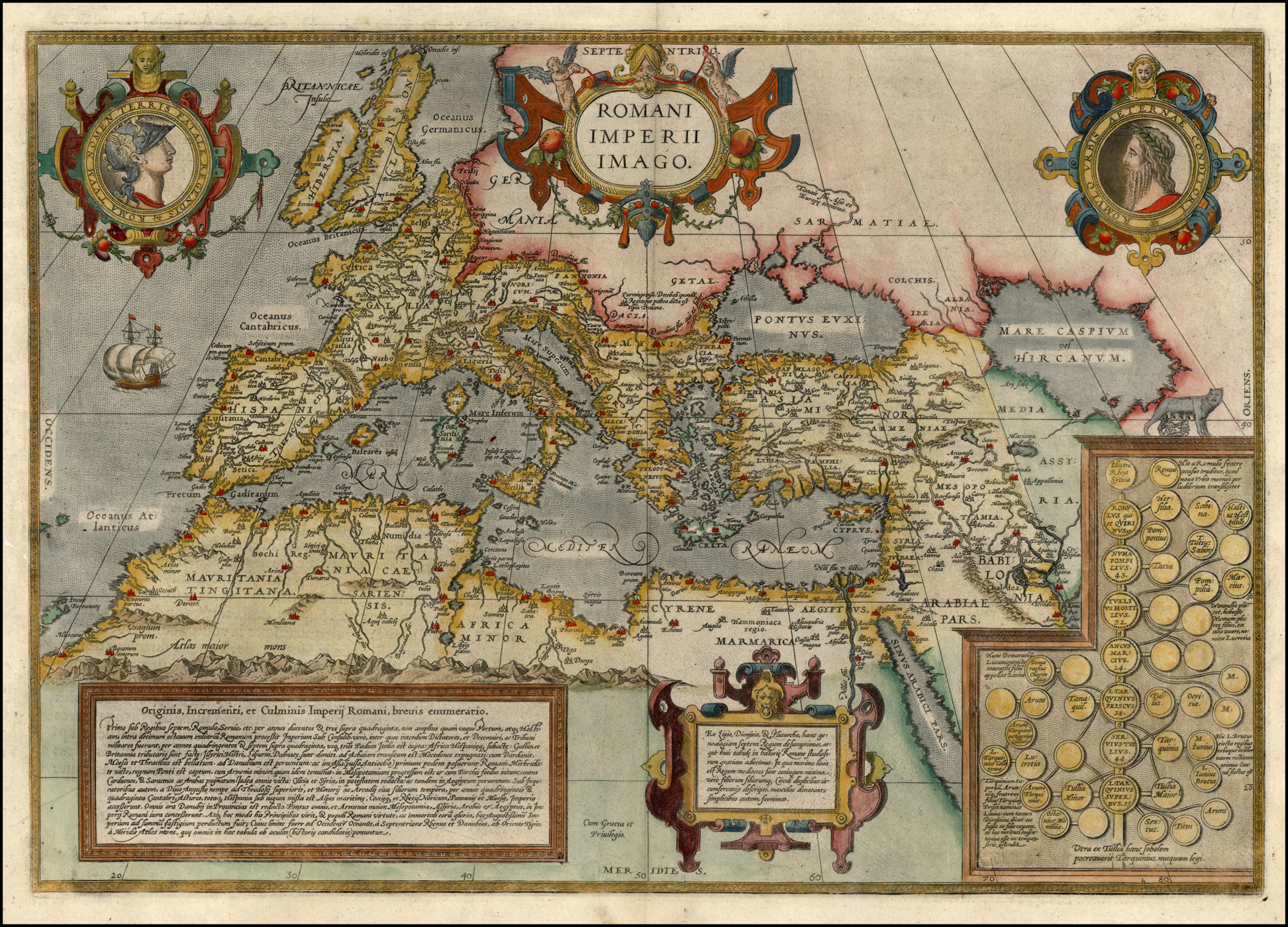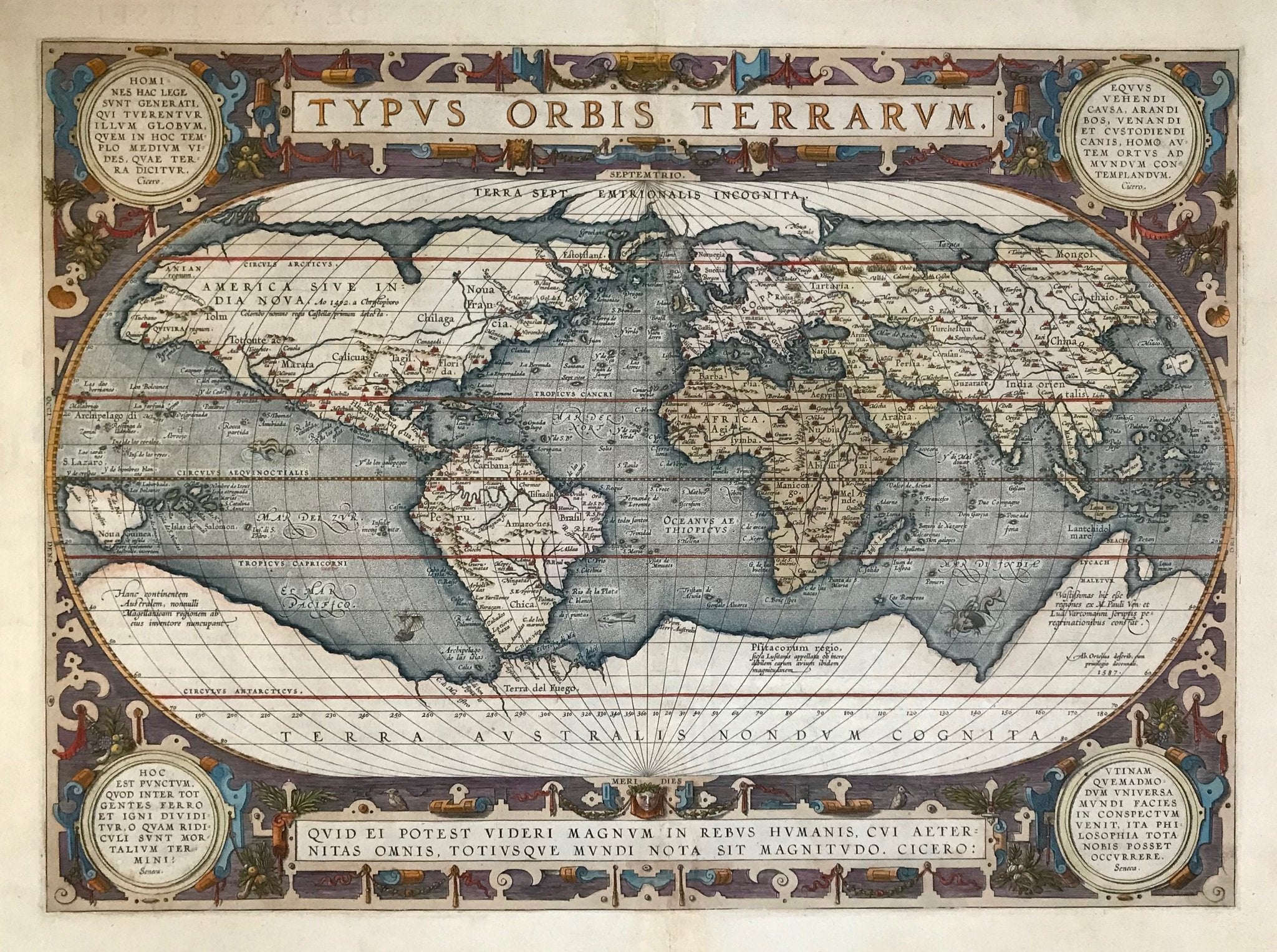
One of the most decorative and popular of all early maps of Africa, from the “golden age” of Dutch mapmaking. From the second volume of Blaeu’s Le theatre dv monde ov Novvel atlas contenant les chartes et descriptions de tous les païs de la terre (Amsterdam, 1644). “Africae nova descriptio.” Copperplate carte à figures map, with added color, 35 x 45 cm. Beautifully designed and engraved, the map represents a high mark of 16th-century mapmaking. Three ships in the lower right are caught in the smoke of battle. No animal or plant life is indicated, but the oceans contain swordfish and a whale. Madagascar appears, as do the place-names of numerous towns along the coasts and in the interior, although large empty spaces begin to dominate there. The “Zanzibar” coastland is featured on the west side, as it is called (Ortelius notes) by Persian and Arab authors, but the island of Zanzibar is correctly placed off the east coast. The Niger now empties into the Atlantic Ocean.

Ortelius uses the Ptolemaic sources of the Nile, two large lakes, but places them farther south. Here, Africa assumes a more recognizable shape, with a more pointed southern cape.

This map comes from a 1584 edition of the atlas, though it still bears the 1570 date. The atlas was phenomenally successful and revered, printed in many editions in seven languages for more than forty years (1570-1612), with an ever increasing number of maps. Each map had text on the back describing the country depicted and listing Ortelius’s sources of information. In 1570, he published the Theatrum, an atlas of fifty-three maps, the first collection of uniform-sized maps depicting all the countries of the known world-the first real atlas. He traveled to many of the great book fairs, established contacts with literati in many countries, collected maps, and became an authority on historical cartography. Ortelius lived and died in Antwerp, where he had a bookselling business. The standard map of Africa for the last quarter of the sixteenth century. From Ortelius’s Theatrum orbis terrarum (Antwerp, 1584). “Africae tabula noua.” Copperplate map, with added color, 37 x 49 cm. Lusitania was a province of the Roman Empire, comprising most of modern Portugal and part of Spain. The text in the large cartouche offers a rudimentary itinerary for sailors from Lusitania to Calechut (Calicut, India), describing a route which essentially avoids Africa. Strangely, this loop disappeared from subsequent maps of Africa for the next two hundred years. Actually, this is the true route of the Niger River, but that fact will not be confirmed until the Lander brothers’ expedition in 1830. One of the intriguing aspects of this map is the loop of the Senegal River, which is shown entering the ocean in today’s Gulf of Guinea. A simplified caravel, similar to those used by the Portuguese (and Columbus), sails off the southern coast.

Few coastal towns are noted, and there is no Madagascar yet.

Several kingdoms are noted, including that of the legendary Prester John, as well as “Meroë,” the mythical tombs of the Nubian kings. The source of the Nile lies in two lakes fed by waters from the fabled Mountains of the Moon, graphically presented as small brown mounds. The Niger River begins and ends in lakes. The map of Africa contains many interesting-if not curious- features: a one-eyed giant seated over Nigeria and Cameroon, representing the mythical tribe of the “Monoculi” a dense forest located in today’s Sahara Desert and an elephant filling southern Africa. Münster was the first mapmaker to print separate maps of the four then known continents (Europe, Africa, Asia, America). By soliciting descriptions and maps from German scholars and foreigners, he was able over time to include up-to-date information in the various editions of his atlases, becoming the most influential cartographer of the mid-16th century. Münster was a professor of Hebrew at Heidelberg and then at Basel, where he settled in 1529 and later died of the plague. Because it was issued with some variations in both of Münster’s very popular works, Geographia (1540-1552) and Cosmographia (1544-1628), the map is difficult to date precisely. The earliest obtainable map of the whole continent of Africa. From Münster’s Cosmographia uniuersalis (Basel, 1554). “Totius Africæ tabula, & descriptio uniuersalis, etiam ultra Ptolemæi limites extensa.” Woodcut map, with added color, 26 x 35 cm.


 0 kommentar(er)
0 kommentar(er)
